The record set in 2001 will be broken in 2002: over the first 11 months of the year, French-language films have attracted 40.2 million spectators in theaters outside France.
2002 has added fuel to the upward trend previously set in motion, thanks to the continuing strength of the Western European market as well as the growth of markets in Central and Eastern Europe and Asia.
French-language films: a trend confirmed
Back in 2001, French-language films pulled in 37.4 million spectators in theaters worldwide (excluding France), compared to an average of 17 million in previous years. 2002 confirms that French cinema's foreign markets are currently in a period of genuine growth. Over the first 11 months of 2002, French-language films registered 40.2 million admissions abroad, with box office takings totaling €218 million. The record set in 2001 has thus been bettered, with these two years standing out as the best seen by French films in at least a decade.
Box office development for French-language films abroad
1995: 16.2 million admissions (€65 million)
1996: 16.2 million admissions (€72.1 million)
1997: 12.8 million admissions (€57.5 million)
1998 : 13.1 million admissions (€66.6 million)
1999: 27 million admissions (€135 million)
2000: 16.6 million admissions (€108.9 million)
2001: 37.4 million admissions (€207.9 million)
These results can be attributed to a great variety of film genres. While "Amelie" dominated the charts for the second year running, having amassed 10 million admissions in 2002 (for a total of 22 million admissions), the Top 20 features titles as diverse as "Asterix & Obelix: Mission Cleopatra," "8 Women," "Wasabi," "Tanguy," "The Pianist," "Read My Lips," "Euro Pudding," "Dead Weight," My Wife is an Actress" and "See How They Run." We can observe, nevertheless, that the top places were largely dominated by productions oriented to teenage audiences.
New developments in the East
Distribution of admissions in the various territories:
Western Europe: 53% (including 35% for the 4 major countries)
Central and Eastern Europe: 13%
North America: 18% (including 14% for the United States)
Latin America: 8%
Asia/Oceania: 7%
Two thirds of these admissions were registered in Europe (in the wider sense of the term), with a significant proportion coming from Eastern European countries, where figures are on a par with the United States. 5 years ago, these countries represented 6%-8% of results – they have now thus almost doubled their contribution.
11 countries registered over 1 million spectators (for French-language films). Strong results were generated by the 3 major European markets (Germany, Spain and Italy), and French-language countries, and we can note the strengthening position of Eastern European countries (Russia and Poland) and Latin America (Argentina and Brazil). Great Britain is conspicuous by its absence, ranked at18th place on a worldwide scale, with a meager 470,000 admissions recorded for French-language films in this period.
A decline in 2002 for foreign-language productions and co-productions
As at the end of November, French films shot in foreign languages posted a downturn compared to 2001: 11.8 million admissions were registered, against around 25 million the previous year (over a 12-month period). The two most prominent films are both English-language productions, majority-financed by France: "The Transporter" and "The Pianist" (Palme d'Or at Cannes 2002). It is worth mentioning that results for foreign-language co-productions traditionally progress in an irregular "seesaw" fashion, and as a result it is difficult to identify a predominant trend for this category of films.
Numerous releases slated for 2003
2003 looks set to witness a significant number of French films hitting movie screens around the world, be they films already launched in the international circuit or titles yet to be released. We can mention the following films among them: "18 Years Later" by Coline Serreau, "He Loves Me... He Loves Me Not" by Lætitia Colombani, "The Adversary" by Nicole Garcia, "Euro Pudding" by Cédric Klapisch, "Belphegor, Phantom of the Louvre" by Jean-Paul Salomé, "Carnage" by Delphine Gleize, "Jet Lag" by Danièle Thompson, "See How They Run" by Michel Blanc, "To Have and To Be" by Nicolas Philibert, "The Son" by the Dardenne brothers, "The Flower of Evil" by Claude Chabrol, "The Man on the Train" by Patrice Leconte, "Irreversible" by Gaspar Noé, "Ni pour, ni contre (bien au contraire)" by Cédric Klapisch, "Novo" by Jean-Pierre Limosin, "Petites coupures" by Pascal Bonitzer, "The Pianist" by Roman Polanski, "La Sirène rouge" by Olivier Mégaton, "Swimming Pool" by François Ozon, "Taxi 3" by Gérard Krawczyk, "Le Temps des loups" by Michael Haneke, "Les Tourtereaux" by Francis Veber, "The Transporter" by Louis Leterrier and "Les Triplettes de Belleville" by Sylvain Chomet.
An underlying trend
French films made a major breakthrough in international markets between 2000 and 2001. The supply of films in the market increased, in particular for productions aimed at youth audiences, leading to the broadening of audiences for French films abroad beyond their traditional core target. This consequently boosted the confidence of foreign distributors, who, by embarking on more ambitious release patterns for their films, contributed to the boom in results.
This boom can also be explained by the fact that until this time French films attained results abroad that were far below their true potential, unlike their market share at home, where French films already benefited from extremely strong marketing and media attention. While in France French films should, by the end of December, finish up with a market share conforming to previous years' averages, results in international territories, on the other hand, are persistently high, with 2002 even outshining 2001. This apparent paradox is linked to the structure of the world market, which is composed of extremely diverse countries in which the dynamics fluctuate in differing ways over time, and in which the programming of the release of French films is spread out over a number of years.
This way of operating gives the international market as a whole a certain stability over time: it progresses according to mid-term trends, not greatly affected by the unpredictable factors influencing the French market on its own. In this way, the trend observed for French films in the international arena, set in motion over the past 4 years, can be seen as extremely positive for the future of French movie production.
For more details concerning the theatrical release of French films abroad in 2002, country by country, please consult our section: "World Facts."












































